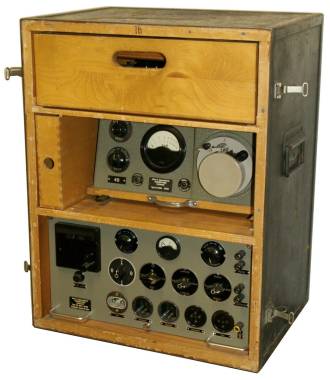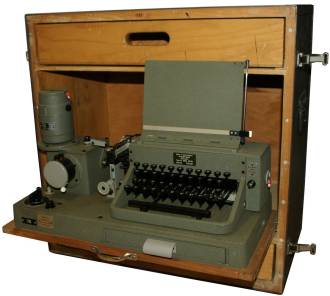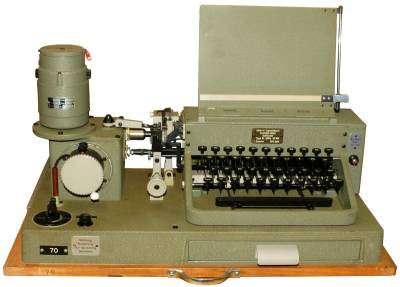Inhaltsverzeichnis
Automat. Morse code equipment Moser
Automatic Morse code equipment Moser, Automatic transmitting equipment SU-ZG-SL 200a resp. AMS; manufactured by Uhren- & Apparatefabrik W. Moser - Baer, Sumiswald.
The company Moser - Baer in Sumiswald, where the precision mechanics / electronics company Mobatec and the (central) clock manufacturer Mobatime (this company produces, among other things, the famous Swiss railway clocks with the jumping second hand) still exist today, developed a high-speed telegraphy system in the 1940s which was used in the Swiss army for training purposes and possibly also in high-speed telegraphy radio operation.


Technical data
- Principle: High-speed telegraphy system Automatic transmitter set AMS
- ZG 200a morse code transmitter
- SU 200a power supply unit
- SL 200a hand punch
- Transmission speed: Transmitter head A: 20 - 200 ZpM, Transmitter head B: 100 - 1000 ZpM
Power supply
- Mains operation: 125, 145, 220, 250 V AC mains; the 110 V AC voltage for the morse code transmitter and the strip punch is provided from the power supply unit.
Dimensions
- Crate A: 650 x 480 x 365 mm, 25.5 kg
- SU 200 a power supply unit: 440 x 220 x 150 mm, 8.2 kg
- ZG 200 a morse code transmitter: 360 x 230 x 150 mm, 9.8 kg
- Crate B: paper tape punch
Accessories
System material
The Morse code transmitting set SU-ZG-SL 200a, the crates are partly labelled AMS, partly „Automat. Morse equipment Moser“, comes from the Moser-Baer clock factory in Sumiswald. The sets have all designations ending in „a“.
The equipment was used for telegraphy training in the Swiss army and possibly also for high-speed telegraphy on short waves, probably from the 1940s onwards.
With the SL 200a paper tape punch, which is stored in the separate crate B (48.5 kg with accessories) and is supplied with 110 V AC voltage from the power supply, a punched paper tape with the text to be transmitted is created first.

The motor speed and therefore the tape speed is controlled by a centrifugal governor. The punching head is used to punch the holes and the paper tape is then moved on by the transport head. Transport holes are created in the centre of the tape, these are also punched when the space bar is pressed (for a word space). To encode a dot, two holes are punched at the same level on both sides of the transport hole; to encode a dash, the two holes on the sides of the transport hole are punched one step apart.
The punched strip is inserted into the character generator in such a way that the second hole of a Morse „line“ comes to the front; it is recommended in the documentation to mark the start of the strip with an arrow when creating it.
For transmitting the prepared message on a tape, the perforated paper tape can be pulled through the encoder & transport head using the transport holes at variable speed. The polarised telegraph relay is activated when the rear contact pin in the encoder head makes contact; if a second hole is at the same height (in the case of a Morse „dot“), the relay receives a current impulse to relase. In the case of a dash, the relay is activated on contact in the rear contact pin, the transport step takes place in the following time period and the touch relay only releases when the front contact pin makes contact with the hole in the offset position, i.e. the dash lasts exactly three times as long as the dot with three half-periods.
The morse code transmitter ZG 200a is equipped with two encoder heads: encoder head A can be used for training at 20 - 200 ZpM, the higher encoder speeds of 100 - 1000 ZpM are intended to be used for high-speed telegraphy. The encoder speed can be regulated on the Zg 200a.

The morse code transmitter and the SU 200a power supply unit, which provides the necessary operating voltage of 110 volts, are housed in a second large-format crate, labelled A, which also weighs 43.5 kg.
Two switches in the SU 200a allow the signal from the morse code transmitter or a connected Morse key to be sent to the keying line, or the signal from a tone generator (tube buzzer with tube EL3) to be sent to the headphone output, for practice operation or, if necessary, for operation with sounding telegraphy A2.


I would be interested in further documentation and information on what this set was used for. As far as I know, it was never used for wireless high-speed telegraphy, but the description states that spare paper rolls were available in the strip punch box „only for use at radio stations“.
Technical principle
Strips prepared with the punch are converted into Morse code in the morse code transmitter at different speeds; a Siemens T.rls 43a telegraph relay activates the transmitter or a tone generator can be used for practice purposes.
Tube configuration
- A selenium rectifier in a Graetz circuit is used to provide the 30 V DC voltage for the encoder and relay circuit.
Development
At the end of the 1940s, Moser-Baer developed a high-speed telegraphy system consisting of a punch for producing punched paper tape and a morse code transmitter with a corresponding power supply unit. The system was used for training purposes and possibly also in wireless stations.
Use
79 systems were procured at a unit price of 11,900 Swiss francs for use in the Signal and Air Force Signal units.
The intended use is still unclear, I would be grateful for further details.








